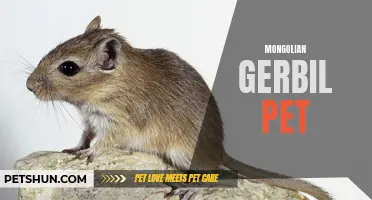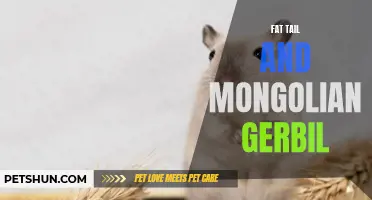
Genetics plays a fascinating role in the diversity and complexity of the animal kingdom. One intriguing example is the Mongolian gerbil, a small rodent with a rich genetic history. With their unique traits and interesting genetic variations, these adorable creatures offer a glimpse into the intricate workings of genetics and the incredible diversity that arises from it. From coat colors and patterns to behavioral tendencies, the genetics of Mongolian gerbils have captivated researchers and enthusiasts alike, allowing us to explore the intricate mechanisms that shape the world of these charming creatures.
| Characteristics | Values |
|---|---|
| Common Name | Mongolian gerbil |
| Scientific Name | Meriones unguiculatus |
| Average Lifespan | 2-4 years |
| Size | 4-5 inches (10-13 cm) |
| Weight | 2-4 ounces (55-110 grams) |
| Coat Color | Various colors, commonly agouti |
| Coat Texture | Dense and soft |
| Eye Color | Black or dark brown |
| Ears | Large and rounded |
| Tail | Long and slender |
| Teeth | Constantly growing incisors |
| Behavioral Traits | Social, curious, burrowing |
| Diet | Herbivorous, primarily seeds and grains |
| Reproduction | Mating for life, gestation of 25-28 days |
| Offspring | Litters of 4-10 pups |
| Predators | Snakes, birds of prey, and carnivorous mammals |
| Habitat | Arid and semi-arid regions |
| Range | Mongolia, China, and Russia |
| Conservation Status | Least Concern |
What You'll Learn
- What are the main genetic traits and characteristics of Mongolian gerbils?
- How do genetics play a role in the health and lifespan of Mongolian gerbils?
- Are there any specific genetic diseases or disorders that are common in Mongolian gerbils?
- What is known about the genetics of coat color and pattern in Mongolian gerbils?
- How do genetics affect the behavior and temperament of Mongolian gerbils?

What are the main genetic traits and characteristics of Mongolian gerbils?
Mongolian gerbils, also known as Mongolian jirds, are small desert-dwelling rodents native to Mongolia and surrounding areas. They are commonly kept as pets due to their friendly temperament and ease of care. One of the fascinating aspects of these furry creatures is their genetic traits and characteristics. In this article, we will explore the main genetic traits and characteristics of Mongolian gerbils.
- Coat Color: Mongolian gerbils exhibit a wide range of coat colors, including agouti, black, white, cinnamon, and grey. These coat colors are determined by various genes that control pigmentation. For example, the agouti gene determines the presence of bands of different colors on individual hairs, resulting in a grizzled or ticked appearance.
- Eye Color: Similar to coat color, eye color in Mongolian gerbils is also genetically controlled. The wild-type eye color is black, though genetic variations can give rise to other colors such as red or pink. These variations are caused by mutations in genes that affect the production or presence of pigments in the iris.
- Coat Patterns: Along with coat color, Mongolian gerbils also exhibit different coat patterns. Common patterns include solid, spotted, agouti, and variegated. These patterns are determined by genes that regulate the distribution of pigments during hair growth.
- Tail Length: Mongolian gerbils have long, tufted tails that aid them in balancing and navigating through their burrows. However, there is some genetic variation in tail length among individuals. Some gerbils may have shorter or longer tails than the average, and these variations are influenced by genetic factors.
- Ear Shape: Another interesting genetic trait in Mongolian gerbils is their ear shape. Most gerbils have round, slightly large ears that help them receive auditory signals efficiently. However, genetic variations can result in different ear shapes, such as pointed or folded. These variations do not affect the gerbil's hearing ability but contribute to their overall appearance.
- Aggression and Social Behavior: While not directly related to genetics, studies have shown that certain genetic factors can influence the aggression levels and social behaviors of Mongolian gerbils. For example, some genetic variations can make individuals more prone to aggressive behaviors or affect their ability to form social bonds with others. These variations highlight the role of genetics in shaping not only physical traits but also behavioral characteristics.
In conclusion, Mongolian gerbils exhibit a variety of genetic traits and characteristics, including coat color, eye color, coat patterns, tail length, ear shape, and even social behavior. Understanding these genetic factors can help breeders select for specific traits or predict the appearance of offspring. Additionally, studying the genetics of Mongolian gerbils can provide valuable insights into the evolutionary history and adaptation of these fascinating rodents.
Exploring the Friendliness of Gerbils: What You Need to Know
You may want to see also

How do genetics play a role in the health and lifespan of Mongolian gerbils?
Genetics play a crucial role in the health and lifespan of Mongolian gerbils. These small rodents, also known as Mongolian jirds or Mongolian desert gerbils, are commonly kept as pets and studied in laboratories. Understanding the genetic factors that influence their health and lifespan can help breeders and researchers improve the well-being of these animals.
Genetic diversity is essential for the overall health and survival of any species, including Mongolian gerbils. Inbreeding, which occurs when closely related individuals mate, can lead to a decrease in genetic diversity, resulting in various health issues. These issues can range from reduced fertility and an increased susceptibility to diseases to developmental abnormalities and reduced lifespan.
To combat the negative effects of inbreeding, breeders should carefully manage the breeding program by introducing new genetic lines periodically. This practice helps maintain genetic diversity and reduces the risk of genetic disorders. Genetic analysis can also be performed to identify individual gerbils with desirable traits and avoid breeding animals that carry harmful genetic mutations.
In addition to maintaining genetic diversity, genetics also play a role in the overall health of Mongolian gerbils. Some genetic factors can influence the susceptibility of gerbils to certain diseases. For example, certain genetic variations have been shown to affect the risk of developing diabetes or certain types of tumors in gerbils. By identifying these genetic variations, researchers can gain insight into the underlying mechanisms of these diseases and potentially develop new treatments or preventive strategies.
Furthermore, genetics can also influence the longevity of Mongolian gerbils. Studies have shown that certain genetic factors can increase or decrease the lifespan of these animals. For instance, researchers have identified specific genes associated with aging processes and longevity in gerbils. Understanding these genetic factors can lead to the development of interventions or treatments that promote healthy aging and extend the lifespan of gerbils.
In conclusion, genetics play a significant role in the health and lifespan of Mongolian gerbils. Maintaining genetic diversity through careful breeding practices is essential to prevent the negative effects of inbreeding. Genetic analysis can help identify desirable traits and avoid breeding animals with harmful genetic mutations. Additionally, understanding the genetic factors that influence disease susceptibility and longevity can aid in the development of preventive strategies and treatments for gerbils. By considering these genetic factors, breeders and researchers can work together to enhance the health and lifespan of Mongolian gerbils.
Why Mongolian Gerbils Are Excellent Pet Companions
You may want to see also

Are there any specific genetic diseases or disorders that are common in Mongolian gerbils?
Mongolian gerbils are popular pets known for their friendly nature and playful personality. However, like any other living organism, gerbils are prone to various genetic diseases and disorders. Understanding these conditions is important for gerbil owners to provide the best care possible for their furry friends.
One common genetic disease in Mongolian gerbils is diabetes. Just like humans, gerbils can develop diabetes due to a malfunctioning pancreas or insulin resistance. Symptoms of diabetes in gerbils include increased thirst, excessive urination, weight loss, and lethargy. If left untreated, diabetes can severely impact a gerbil's overall health and well-being. Regular check-ups with a veterinarian and a balanced diet can help prevent or manage this condition.
Another genetic disorder that affects Mongolian gerbils is epilepsy. Epilepsy is characterized by recurrent seizures or convulsions, which can range from mild to severe. Seizures in gerbils may be triggered by stress, sudden loud noises, or hormonal imbalances. Owners should provide a calm and stress-free environment for their gerbils and consult with a veterinarian for proper diagnosis and treatment.
One unique genetic condition seen in Mongolian gerbils is called "waltzing syndrome." Gerbils affected by waltzing syndrome exhibit an abnormal gait and a spinning or twirling motion. This condition is caused by an inheritable defect in the inner ear, leading to problems with balance and coordination. While there is no cure for waltzing syndrome, gerbil owners can make adjustments to the gerbil's environment to ensure their safety and minimize the impact of the condition on their daily lives.
It is important to note that while these genetic diseases and disorders are common in Mongolian gerbils, not all gerbils will develop them. Proper breeding practices can help reduce the likelihood of passing on these conditions to offspring. Responsible gerbil breeders should screen for genetic diseases before breeding and avoid pairing gerbils that are carriers of these conditions.
In conclusion, while Mongolian gerbils are generally healthy pets, they are prone to certain genetic diseases and disorders. Diabetes, epilepsy, and waltzing syndrome are some of the conditions that gerbil owners should be aware of. Regular veterinary check-ups, a balanced diet, and a stress-free environment can help manage and prevent these conditions. Responsible breeding practices can also contribute to reducing the prevalence of these genetic diseases in gerbils.
Battle of the Pets: Gerbils vs Rats - Which is the Better Companion?
You may want to see also

What is known about the genetics of coat color and pattern in Mongolian gerbils?
Mongolian gerbils, also known as Mongolian jirds or Mongolian gerbili, are small rodents native to Mongolia and China. They are popular pets due to their friendly nature and easy care requirements. One interesting aspect of Mongolian gerbils is their coat color and pattern, which can vary greatly among individuals. In recent years, scientists have made significant progress in understanding the genetics behind these variations.
Coat color in Mongolian gerbils is determined by several genes, each of which contributes to the overall pigmentation of the fur. One of the most well-studied genes involved in coat color is the Melanocortin 1 Receptor (MC1R) gene. This gene controls the production of melanin, the pigment responsible for the coloration of the hair, skin, and eyes. Different versions, or alleles, of the MC1R gene can result in a wide range of coat colors, including agouti, black, brown, and cream.
The agouti phenotype is the most common coat color variation in Mongolian gerbils. It is characterized by a light-colored belly and a darker back, with alternating bands of color along the length of the body. The agouti pattern is caused by the interaction of two genes: the agouti signaling protein (ASIP) gene and the Agouti locus protein (Agouti) gene. These genes work together to control the distribution of eumelanin and pheomelanin, two types of melanin that determine the dark and light areas of the fur, respectively.
In addition to coat color, Mongolian gerbils can also exhibit different coat patterns, such as stripes or spots. These patterns are mainly controlled by genes involved in the development and organization of hair follicles. For example, the Brt1 gene is responsible for the formation of stripes, while the Spotting gene determines the presence of spots. The interaction between these genes and the MC1R gene can result in various combinations of coat color and pattern, further contributing to the diversity observed in Mongolian gerbils.
Understanding the genetics of coat color and pattern in Mongolian gerbils is not only fascinating from a scientific perspective but also has practical implications for breeders and pet owners. By selectively breeding individuals with specific coat characteristics, breeders can create gerbils with desired traits, such as rare colorations or unique patterns. Additionally, identifying the genetic basis of coat color and pattern can help veterinarians diagnose certain health conditions or diseases that may be associated with particular genetic mutations.
In conclusion, the genetics of coat color and pattern in Mongolian gerbils is a complex but fascinating field of study. Through years of research, scientists have identified several genes involved in the determination of coat color and pattern. This knowledge not only enhances our understanding of the gerbil's biology but also allows breeders to selectively breed individuals with specific coat characteristics. Further research in this area will undoubtedly uncover more about the intricate genetic mechanisms that govern the diversity seen in Mongolian gerbils.
Are Gerbils Social Animals? Exploring Whether Gerbils Can Live Together
You may want to see also

How do genetics affect the behavior and temperament of Mongolian gerbils?
Mongolian gerbils, also known as desert gerbils, are small rodents that are known for their sociable and curious nature. While their behavior and temperament can vary from individual to individual, genetics plays a significant role in shaping their personality traits. In this article, we will explore how genetics affect the behavior and temperament of Mongolian gerbils.
Genetics, or the study of heredity, determines the genetic makeup of an organism. This includes traits such as coat color, body size, and behavior. In the case of Mongolian gerbils, certain genes are responsible for their behavioral characteristics. For example, some gerbils may be more adventurous and outgoing, while others may be more shy and reserved. These differences can be attributed to variations in specific genes that control their nervous system development.
Studies have shown that certain genes, such as those involved in dopamine regulation, can influence the behavior of Mongolian gerbils. Dopamine is a neurotransmitter that plays a role in reward-motivated behavior and pleasure sensations. Variations in genes related to dopamine receptors can result in differences in exploratory behavior and responsiveness to stimuli.
Furthermore, genetics can also influence the temperament of Mongolian gerbils. Temperament refers to an animal's innate predisposition to certain behaviors and reactions. Some gerbils may have a more laid-back and easy-going temperament, while others may be more feisty and aggressive. These differences can be attributed to variations in genes that regulate the gerbil's stress response and hormone levels.
For example, the corticosterone receptor gene has been found to influence stress levels and coping mechanisms in Mongolian gerbils. Individuals with certain variations in this gene may be more reactive to stressful situations and exhibit heightened aggression or anxiety. On the other hand, gerbils with different variations of this gene may be more calm and resilient in the face of stressors.
It is important to note that while genetics may predispose gerbils to certain behaviors and temperaments, their environment and experiences also play a crucial role. The gerbil's early life experiences, including socialization, handling, and exposure to different stimuli, can greatly influence their behavior and temperament.
In conclusion, genetics plays a significant role in shaping the behavior and temperament of Mongolian gerbils. Specific genes related to the nervous system development, dopamine regulation, and stress response can influence their adventurousness, sociability, and reactivity to stimuli. However, it is important to consider that genetics alone does not determine the behavior and temperament of gerbils, as environmental factors also play a crucial role. By understanding the genetic factors that contribute to their behavior, we can gain insights into how to provide the best care and enrichment for these curious and sociable rodents.
The Fascinating World of Female Gerbils: Everything You Need to Know
You may want to see also
Frequently asked questions
The lifespan of a Mongolian gerbil is typically 2-4 years. However, with proper care and a healthy diet, they can sometimes live up to 5 years.
Mongolian gerbils are generally healthy animals, but they can be prone to certain genetic health issues. One common issue is epilepsy, which can be passed down through genetic lines. Breeders should be cautious and avoid breeding gerbils with a history of epilepsy to minimize the risk of passing it on to offspring.
Yes, the coat colors of Mongolian gerbils are determined by genetics. There are several different coat colors and patterns, including agouti, black, white, and pied. These traits are inherited from the gerbil's parents and can be predicted using Mendelian genetics principles.
Yes, certain behavioral traits in Mongolian gerbils can be inherited. For example, aggression or tameness can be influenced by genetics. Breeders should be aware of the temperament of their breeding stock and work towards selecting individuals with desired behavioral traits to pass on to future generations.







